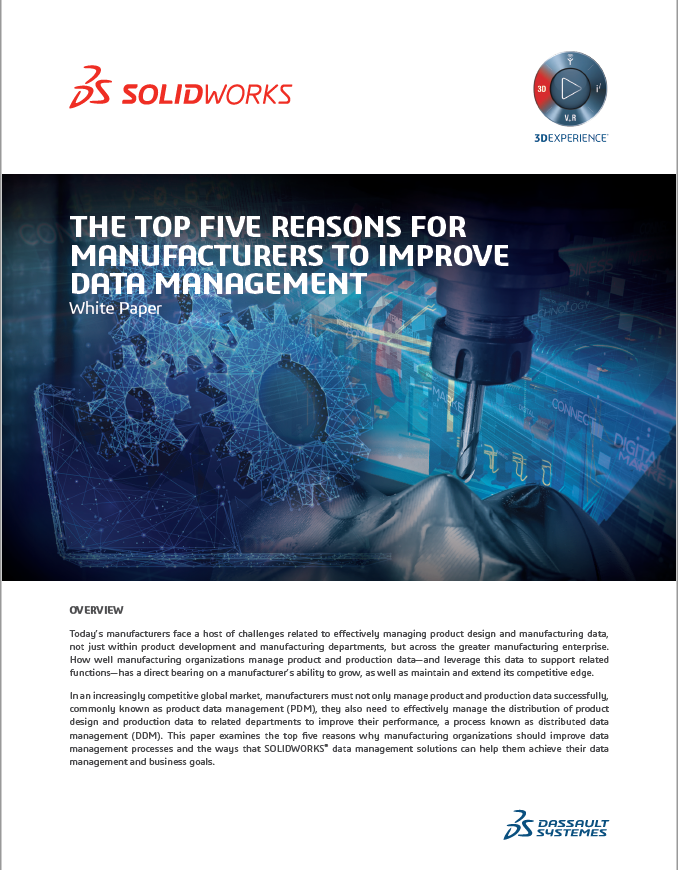This is Part 2 of our 6-part blog series based on our white paper, “The Top Five Reasons for Manufacturers to Improve Data Management.”
Reason #2: Improve Product Quality
By improving data management, manufacturing organizations will be able to sustain consistently high levels of quality by doing the following:
- Eliminating Revision Errors – Shoddy product quality caused by working with old, out-ofdate revisions was fairly common when data management consisted of physically filing paper drawings in cabinets and drawers. With a PDM (product data management) system’s tighter revision controls, you can completely eliminate design errors and product issues associated with working with the wrong revision of a product design.
- Achieving Greater Design Reuse – Why design a new component when a perfectly good, tested design for the part already exists, buried somewhere in your product data? Of course, if you can’t find an existing design, you can’t reuse it. Data management tools with search capabilities can help your manufacturing organization increase reuse of proven, existing designs. As design reuse grows, product quality improves.
- Reducing Scrap and Rework – Design errors—whether related to use of an out-of-date revision or a new, untested design—have ramifications on a manufacturer’s volume of costly scrap and rework. Any time that a manufacturer needs to rework or retrofit a part or product, the probability that the rework will negatively impact quality grows. A PDM system can help manufacturers weed out revision errors, increase design reuse, and reduce scrap and rework, all of which can help your organization improve product quality
- Improving Handling of Engineering Change Orders – When a design or engineering change is required after a product design has already been released for production, manufacturers issue an engineering change order (ECO). How well your organization implements ECOs—and how many ECOs are issued—has a direct bearing on overall product quality. With an integrated PDM system, manufacturers not only can execute ECOs more efficiently but also can ensure that the handling of ECOs produces the end result of improving quality
A Case in Point: Improving Product Quality at Vermeer
Vermeer’s ECN (engineering change) management has become fully automated, tightly controlled, and virtually fail-safe because of the 3DEXPERIENCE platform.
“Our ECN process is quite complex with a different series of tasks for various personnel,” notes Greg Johnson, senior applications specialist. “All these things have to be done before an engineering change is made, with several checks and balances built into the process. With Enterprise Product Data Management, the entire process is controlled by the system, which guarantees all steps are followed and no steps are missed. The system even walks each user through the steps for which he or she is responsible. Automating this process has accelerated and improved ECN management.”
As a result, Vermeer has automated its development workflows, increased development and production throughput, shortened and formalized its engineering change process, and improved the quality of its products and documentation.
To read the full Vermeer Case Study, download the white paper.
Part 1: Reason #1 – Boost Productivity
Part 2: Reason #2 – Improve Product Quality
Part 3: Reason #3 – Facilitate Collaboration
Part 4: Reason #4 – Increase Agility & Flexibility
Part 5: Reason #5 – Inspire Innovation
Part 6: Make Data Management a Competitive Strength with NETVIBES on the 3DEXPERIENCE platform
Download the “Top Five Reasons for Manufacturers to Improve Data Management” white paper

Join our User Communities to stay on top of the latest industry news, ask questions and collaborate with peers:
- EXALEAD Sourcing & Standardization Intelligence User Community
- 3DEXPERIENCE Marketplace | PartSupply User Community
- NETVIBES Public Community

